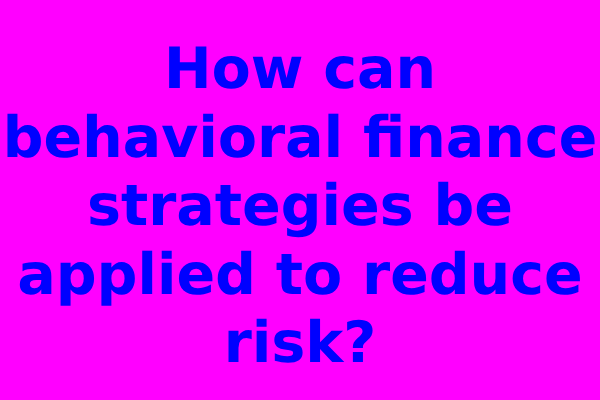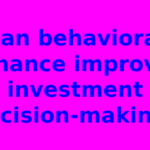Introduction:
In this article, I’ll delve into the intriguing realm of behavioral finance and its practical application in risk reduction strategies. Behavioral finance is a branch of finance that explores how psychological biases and cognitive errors influence investment decisions, often leading to suboptimal choices. By understanding these cognitive quirks, investors can devise strategies to mitigate risk and enhance the overall effectiveness of their investment portfolios.
Traditional finance models assume that investors are perfectly rational and make decisions based on all available information. However, the reality often diverges from this idealized notion. Investors are susceptible to various emotional and cognitive biases, such as overconfidence, loss aversion, and herding behavior, which can significantly impact their risk management decisions. By acknowledging these behavioral tendencies and integrating them into investment strategies, it is possible to create more resilient and risk-aware investment approaches. This article will explore various behavioral finance concepts and how they can be harnessed to reduce risk in the dynamic world of financial markets.
Cognitive Biases Awareness:
Cognitive biases play a pivotal role in behavioral finance strategies for risk reduction. These biases are inherent mental shortcuts or patterns of thinking that can lead to irrational decision-making in financial contexts. To mitigate risk effectively, investors need to first become aware of these biases and their impact on their judgment. Common biases include overconfidence, anchoring, and confirmation bias, among others. By recognizing these tendencies within themselves, investors can make more informed and rational decisions.
Awareness of cognitive biases enables investors to adopt a critical mindset and question their assumptions. For example, if an investor is aware of their tendency to anchor to the purchase price of a stock, they may be more open to adjusting their expectations based on new information, reducing the potential for substantial losses. Additionally, cognitive biases awareness encourages self-reflection, helping investors identify when they may be susceptible to these biases, and develop strategies to counteract them.
Incorporating cognitive biases awareness into risk reduction strategies requires ongoing education and self-assessment. Investors can engage in training programs, read behavioral finance literature, and even seek guidance from financial advisors who are well-versed in this area. By continually monitoring and addressing cognitive biases, investors can better protect their portfolios from the detrimental consequences of irrational decision-making.
Risk Perception Adjustments:
In behavioral finance, one of the fundamental concepts for risk reduction involves adjusting risk perception. Traditional finance theory assumes that investors make rational decisions, precisely weighing the risks and rewards of an investment. However, behavioral finance recognizes that individuals often perceive and react to risks differently, influenced by emotions and cognitive biases.
To reduce risk effectively, investors must understand and adjust their perception of risk. This entails acknowledging that they may have a biased perception of the likelihood and impact of potential losses or gains. For example, loss aversion bias can make investors excessively fearful of losses, leading them to sell assets prematurely, which might result in missed opportunities for recovery. By recognizing these biases and consciously adjusting their risk perception, investors can make more balanced and well-informed decisions.
Investors can apply several strategies to adjust their risk perception, such as adopting a systematic approach to risk assessment, using financial models, and conducting scenario analysis. These tools help investors quantify and analyze risk more objectively, reducing the influence of emotional and cognitive biases. Additionally, diversification, as mentioned in the next point, can also help in reducing perceived risk by spreading investments across different asset classes, thereby balancing potential losses.
Diversification Strategies:
Diversification is a cornerstone of risk reduction in behavioral finance. Investors have a natural tendency to be risk-averse, which can lead to over-concentration in a single asset or asset class, exposing them to significant risks if that asset underperforms. Behavioral finance strategies advocate diversifying one’s investment portfolio to reduce this concentration risk.
Diversification involves spreading investments across a range of assets, such as stocks, bonds, real estate, and commodities, as well as different industries and geographical regions. This approach minimizes the potential impact of poor performance in one area of the portfolio, thereby reducing the overall risk. Behavioral finance recognizes that emotional biases, like loss aversion, can cause investors to panic and make irrational decisions when a single investment suffers losses. Diversification helps temper these emotional responses by limiting the extent of any one loss.
Investors can apply diversification strategies by developing a well-balanced portfolio that aligns with their risk tolerance and financial goals. Asset allocation, where they decide the proportion of different asset classes, is a key element of this strategy. Periodic rebalancing is essential to maintain the desired diversification level as market conditions change. Diversification not only mitigates risk but also enhances the potential for consistent, long-term returns, making it a critical tool in behavioral finance for risk reduction.
Emotional Self-Control:
Emotional self-control is a fundamental aspect of risk reduction in behavioral finance. Human emotions can significantly influence financial decisions and often lead to impulsive actions that increase risk. Behavioral finance strategies encourage investors to develop emotional self-control by acknowledging their emotional responses and learning to manage them effectively.
Emotional self-control involves recognizing common emotions that impact financial decisions, such as fear, greed, and panic. When investors experience these emotions, they may make hasty decisions like selling assets during a market downturn or chasing speculative investments during a bubble. By acknowledging these emotional triggers, investors can develop strategies to prevent their emotions from driving impulsive actions.
Investors can cultivate emotional self-control through mindfulness techniques, setting clear investment goals, and having a well-defined investment plan that includes predefined exit and entry points. Furthermore, seeking the support of a financial advisor can provide an external perspective and offer guidance during emotional market conditions. By practicing emotional self-control, investors can avoid impulsive decisions that often lead to increased risk and losses, ultimately contributing to a more balanced and stable portfolio.
Long-Term Perspective Adoption:
Adopting a long-term perspective is another critical behavioral finance strategy for risk reduction. In traditional finance, investors may be swayed by short-term market fluctuations and news events, leading to reactionary decisions that can increase risk. Behavioral finance emphasizes the importance of focusing on long-term financial goals and staying committed to a well-thought-out investment strategy.
A long-term perspective encourages investors to ride out market volatility and not react impulsively to short-term fluctuations. By shifting their attention away from daily market noise and instead concentrating on their long-term goals, investors can reduce the risk of making detrimental, emotionally-driven decisions.
To adopt a long-term perspective, investors can create a comprehensive financial plan that outlines their objectives, risk tolerance, and investment horizon. They should also periodically review and adjust their plan to ensure it aligns with their changing financial circumstances. Additionally, employing techniques like dollar-cost averaging, where investors consistently invest a fixed amount of money over time, can help mitigate the impact of market volatility and support a long-term approach. Ultimately, the adoption of a long-term perspective is a key element in behavioral finance for reducing risk and achieving more stable, consistent returns.
Decision-Making Frameworks:
Behavioral finance strategies for risk reduction often involve implementing structured decision-making frameworks. Traditional finance assumes that investors make rational decisions based on all available information. However, behavioral finance recognizes that individuals are susceptible to cognitive biases and emotions, leading to irrational choices. Decision-making frameworks provide a structured approach to counteract these biases and enhance the rationality of investment decisions.
Various decision-making frameworks exist in behavioral finance, such as prospect theory and bounded rationality. Prospect theory suggests that individuals weigh potential gains and losses differently and are more sensitive to potential losses. This insight helps investors make more rational decisions by considering their emotional responses to gains and losses. Bounded rationality acknowledges that investors have limited cognitive resources and tend to make decisions based on simplified heuristics or rules of thumb. By understanding these limitations, investors can develop strategies to make more informed and consistent choices.
Implementing decision-making frameworks requires investors to educate themselves about these frameworks and apply them in their decision-making processes. They can also seek guidance from financial professionals well-versed in these approaches. Decision-making frameworks in behavioral finance are indispensable tools for reducing the impact of emotional and cognitive biases on investment decisions, ultimately leading to more rational and less risky choices.
Contrarian Investing Tactics:
Contrarian investing tactics are essential in behavioral finance for risk reduction. These tactics involve going against the prevailing market sentiment, which is often influenced by emotional biases and herd behavior. Behavioral finance recognizes that market sentiment can lead to asset bubbles and market crashes, and contrarian strategies aim to reduce risk by taking advantage of these sentiment-driven extremes.
Contrarian investors actively seek opportunities when others are overly pessimistic or optimistic. For example, during a market bubble, contrarians may consider selling overvalued assets, reducing exposure to excessive risk. Conversely, during market downturns when fear prevails, contrarians may identify undervalued assets and seize buying opportunities. These strategies help investors avoid the pitfalls of following the crowd, which can lead to buying high and selling low.
Contrarian investing tactics require investors to conduct thorough research, identify signs of market sentiment extremes, and have the courage to go against the prevailing trend. This approach can be psychologically challenging, as it often involves making decisions that feel counterintuitive. However, when applied correctly, contrarian strategies can help reduce risk by avoiding emotional-driven, herd-like behavior.
Scenario Analysis Implementation:
Scenario analysis is a valuable tool in behavioral finance for risk reduction. This strategy involves examining a range of potential future scenarios and assessing how different factors and events may impact investment outcomes. By exploring these scenarios, investors can make more informed decisions and reduce the risk of being caught off guard by unexpected developments.
Scenario analysis is particularly useful in reducing risk associated with uncertainty. In finance, unforeseen events, such as economic crises, geopolitical tensions, or technological advancements, can significantly influence asset values and investment performance. By considering various scenarios, investors can develop strategies that are robust and adaptable to a wide range of potential outcomes.
To implement scenario analysis, investors need to identify key variables and drivers of their investments, create a range of plausible scenarios, and assess how their portfolio would perform under each scenario. This process allows investors to better understand the potential risks and rewards associated with their investments and make adjustments accordingly. By incorporating scenario analysis into their decision-making process, investors can proactively manage risk and enhance their portfolio’s resilience in an ever-changing financial landscape.
Conclusion:
I hope this exploration of behavioral finance strategies for risk reduction has shed light on the transformative power of understanding and incorporating human psychology into financial decision-making. In a world where markets are not always rational and emotions often drive actions, these strategies offer a pragmatic way to navigate the complex landscape of investments.
Behavioral finance highlights the importance of cognitive biases awareness, risk perception adjustments, diversification, emotional self-control, and adopting a long-term perspective. These elements provide a foundation for more rational and less emotionally-driven decision-making. Decision-making frameworks, contrarian tactics, and scenario analysis further empower investors to mitigate risk by making informed and adaptive choices.


